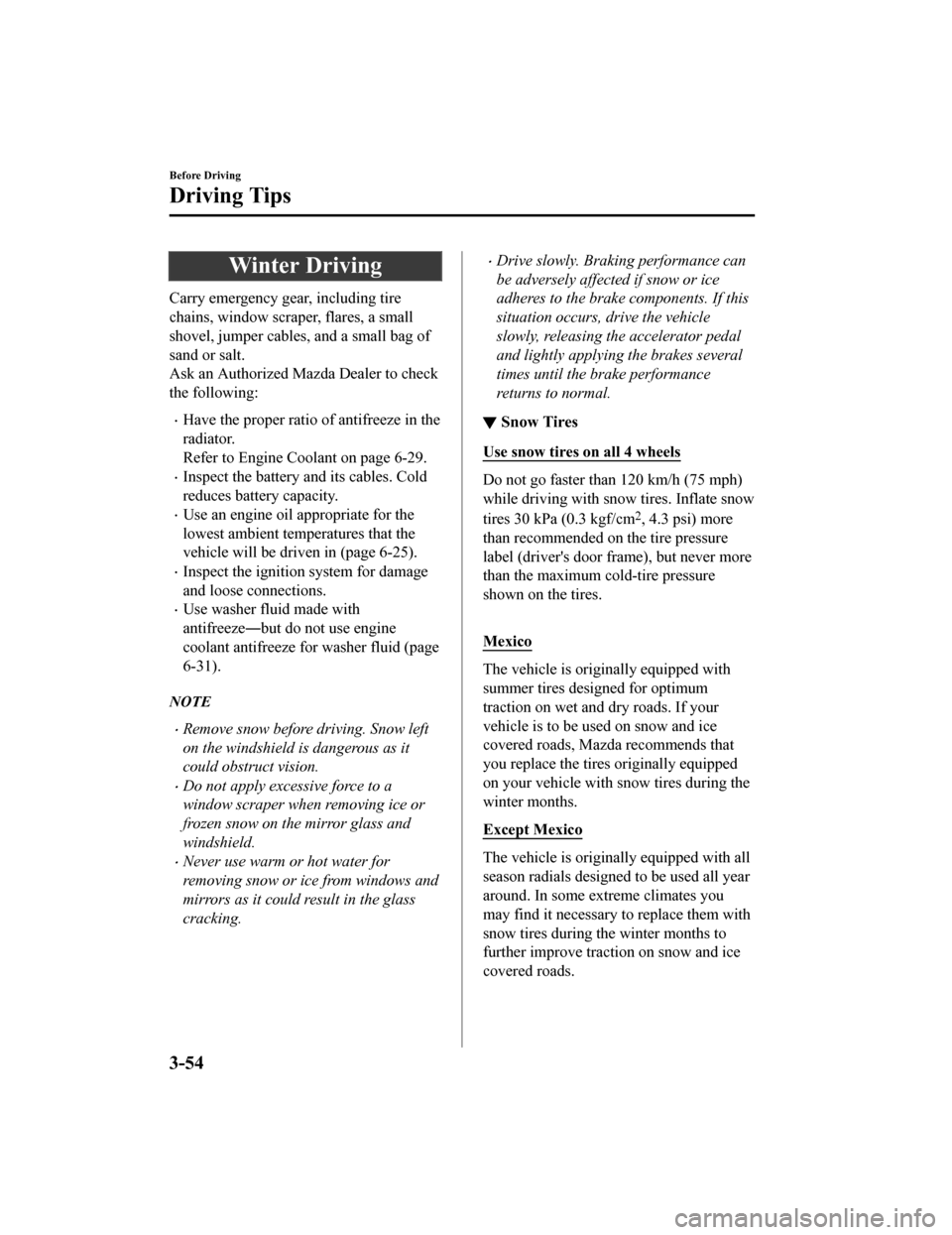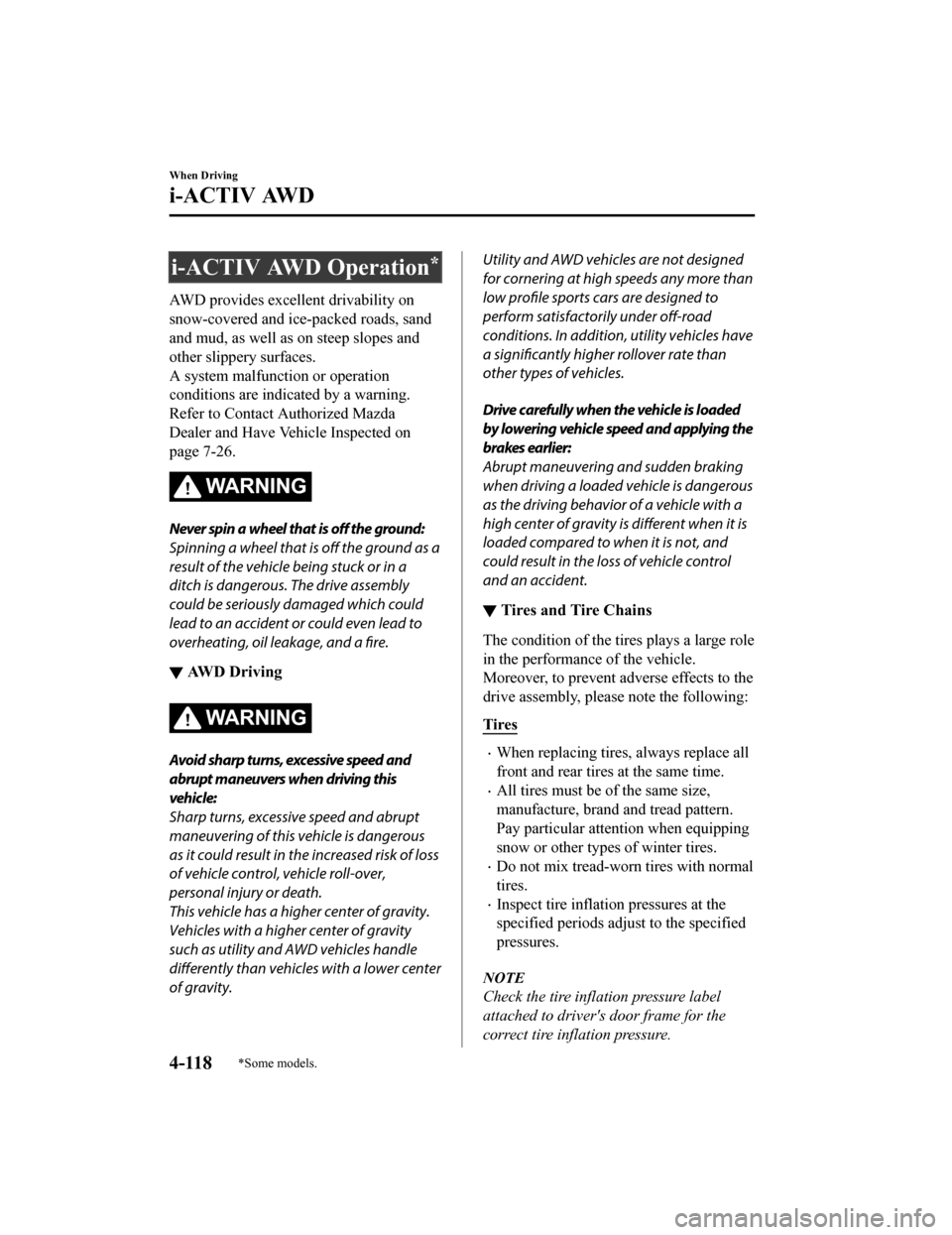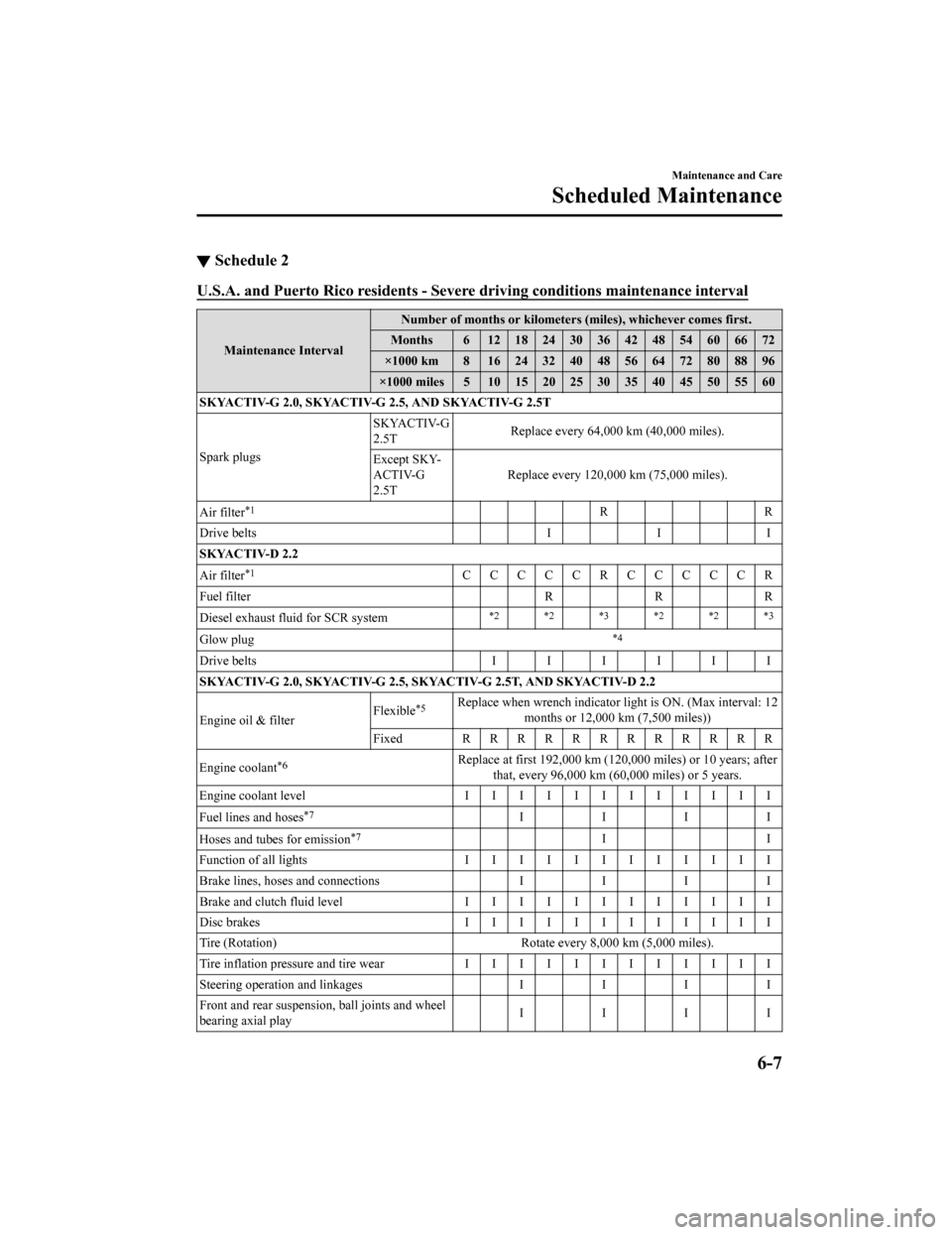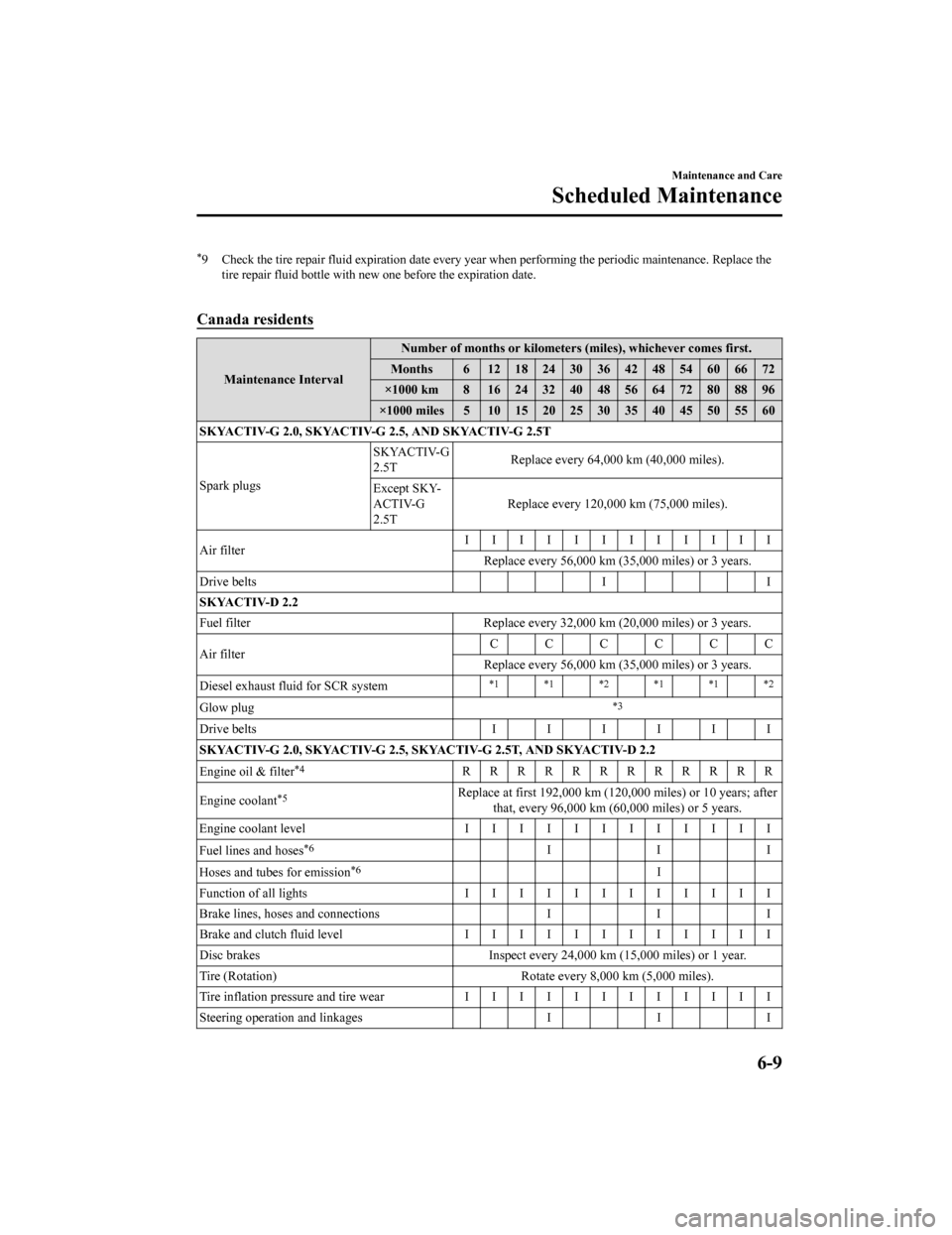low oil pressure MAZDA MODEL CX-5 2020 Owners Manual (in English)
[x] Cancel search | Manufacturer: MAZDA, Model Year: 2020, Model line: MODEL CX-5, Model: MAZDA MODEL CX-5 2020Pages: 714
Page 144 of 714

Winter Driving
Carry emergency gear, including tire
chains, window scraper, flares, a small
shovel, jumper cables, and a small bag of
sand or salt.
Ask an Authorized Mazda Dealer to check
the following:
Have the proper ratio of antifreeze in the
radiator.
Refer to Engine Coolant on page 6-29.
Inspect the battery and its cables. Cold
reduces battery capacity.
Use an engine oil appropriate for the
lowest ambient temperatures that the
vehicle will be driven in (page 6-25).
Inspect the ignition system for damage
and loose connections.
Use washer fluid made with
antifreeze―but do not use engine
coolant antifreeze for washer fluid (page
6-31).
NOTE
Remove snow before driving. Snow left
on the windshield is dangerous as it
could obstruct vision.
Do not apply excessive force to a
window scraper when removing ice or
frozen snow on the mirror glass and
windshield.
Never use warm or hot water for
removing snow or ice from windows and
mirrors as it could result in the glass
cracking.
Drive slowly. Braking performance can
be adversely affected if snow or ice
adheres to the brake components. If this
situation occurs, drive the vehicle
slowly, releasing the accelerator pedal
and lightly applying the brakes several
times until the brake performance
returns to normal.
▼ Snow Tires
Use snow tires on all 4 wheels
Do not go faster than 120 km/h (75 mph)
while driving with snow
tires. Inflate snow
tires 30 kPa (0.3 kgf/cm
2, 4.3 psi) more
than recommended on the tire pressure
label (driver's door frame), but never more
than the maximum cold-tire pressure
shown on the tires.
Mexico
The vehicle is originally equipped with
summer tires designed for optimum
traction on wet and dry roads. If your
vehicle is to be used on snow and ice
covered roads, Mazda recommends that
you replace the tires originally equipped
on your vehicle with snow tires during the
winter months.
Except Mexico
The vehicle is originally equipped with all
season radials designed to be used all year
around. In some extreme climates you
may find it necessary to replace them with
snow tires during the winter months to
further improve traction on snow and ice
covered roads.
Before Driving
Driving Tips
3-54
CX-5_8HX6-EA-19I_Edition2_old 2019-9-19 9:26:07
Page 183 of 714

SignalWarning Page
Electric Parking Brake (EPB) Warning Indication/Warning Light*17-26
Check Engine Light*17-26
*Selective Catalytic Reduction (SCR) system Warning Indication/Warning
Light*17-26
Automatic Transaxle Warning Indication 7-26
*AWD Warning Indication7-26
Air Bag/Front Seat Belt Preten
sioner System Warning Light*17-26
Tire Pressure Monitoring System Warning Light*1
Flashing
7-26
Turns on 7-33
(Amber/White) KEY Warning Indication Amber
7-26
White 7-33
(Amber) High Beam Control System (HBC) Warning Indication/Warning Light
*17-26
Blind Spot Monitoring (B
SM) Warning Indication 7-26
(Amber)Mazda Radar Cruise Control with Stop & Go function (MRCC with Stop &
Go function) Warning Indication
7-26
Lane-keep Assist System (LAS) & Lane Departure Warning System
(LDWS) Warning Indication7-26
LED Headlight Warning Light*17-26
Smart Brake Support/Smart City Brak
e Support (SBS/SCBS) Warning Indi-
cation 7-33
Low Fuel Warning Indication/Warning Light
7-33
Check Fuel Cap Warning Indication/Warning Light*17-33
Engine Oil Level Warning Light*17-33
Seat Belt Warning Light (Front seat)7-33
When Driving
Instrument Cluster and Display
*Some models.4-25
CX-5_8HX6-EA-19I_Edition2_old 2019-9-19 9:26:07
Page 212 of 714

SignalWarning Page
(Red)Brake Pedal Operation Demand Warning Light
*1
Flashing
4-101
Buzzer & Flash- ing
7-26
Check Engine Light*17-26
*Automatic Transaxle Warning Light*17-26
*AWD Warning Light 7-26
Air Bag/Front Seat Belt Pretensioner System Warning Light*17-26
*Tire Pressure Monitoring System Warning Light*1
Flashing
7-26
Turns on 7-33
(Red) KEY Warning Light
*1
Turns on
7-26
Flashing 7-33
LED Headlight Warning Light*17-26
(Amber)
*Smart City Brake Support (SCBS) Warning Light*17-33
Low Fuel Warning Light 7-33
Check Fuel Cap Warning Light*17-33
Engine Oil Level Warning Light*17-33
Seat Belt Warning Light (Front seat) 7-33
(Red)Seat Belt Warning Light (Rear seat) 7-33
*Low Washer Fluid Level Warning Light
7-33
Door-Ajar Warning Light
7-33
When Driving
Instrument Cluster and Display
4-54*Some models.
CX-5_8HX6-EA-19I_Edition2_old 2019-9-19 9:26:07
Page 276 of 714

i-ACTIV AWD Operation*
AWD provides excellent drivability on
snow-covered and ice-packed roads, sand
and mud, as well as on steep slopes and
other slippery surfaces.
A system malfunction or operation
conditions are indicated by a warning.
Refer to Contact Authorized Mazda
Dealer and Have Vehicle Inspected on
page 7-26.
WA R N I N G
Never spin a wheel that is off the ground:
Spinning a wheel that is off the ground as a
result of the vehicle being stuck or in a
ditch is dangerous. The drive assembly
could be seriously damaged which could
lead to an accident or could even lead to
overheating, oil leakage, and a fire.
▼AWD Driving
WA R N I N G
Avoid sharp turns, excessive speed and
abrupt maneuvers when driving this
vehicle:
Sharp turns, excessive speed and abrupt
maneuvering of this
vehicle is dangerous
as it could result in the increased risk of loss
of vehicle control, vehicle roll-over,
personal injury or death.
This vehicle has a higher center of gravity.
Vehicles with a higher center of gravity
such as utility and AWD vehicles handle
differently than vehicles with a lower center
of gravity.
Utility and AWD vehicles are not designed
for cornering at high speeds any more than
low profile sports cars are designed to
perform satisfactorily under off-road
conditions. In addition, utility vehicles have
a significantly higher rollover rate than
other types of vehicles.
Drive carefully when the vehicle is loaded
by lowering vehicle speed and applying the
brakes earlier:
Abrupt maneuvering and sudden braking
when driving a loaded vehicle is dangerous
as the driving behavior of a vehicle with a
high center of gravity is different when it is
loaded compared to when it is not, and
could result in the loss of vehicle control
and an accident.
▼ Tires and Tire Chains
The condition of the tires plays a large role
in the performance of the vehicle.
Moreover, to prevent adverse effects to the
drive assembly, please note the following:
Tires
When replacing tires, always replace all
front and rear tires at the same time.
All tires must be of the same size,
manufacture, brand and tread pattern.
Pay particular attention when equipping
snow or other types of winter tires.
Do not mix tread-worn tires with normal
tires.
Inspect tire inflation pressures at the
specified periods adju
st to the specified
pressures.
NOTE
Check the tire inflation pressure label
attached to driver's door frame for the
correct tire inflation pressure.
When Driving
i-ACTIV AWD
4-118*Some models.
CX-5_8HX6-EA-19I_Edition2_old 2019-9-19 9:26:07
Page 371 of 714

Do not use the front bumper to push other vehicles or obstructions such as when pulling
out of a parking space. Otherwise, the radar sensor (front) could be hit and its position
deviated.
Do not remove, disassemble, or mo dify the radar sensor (front).
For repairs, replacement or paint work ar ound the radar sensor (front), consult an
Authorized Mazda Dealer.
Do not modify the suspension. If the suspensi on are modified, the vehicle's posture could
change and the radar sensor (front) may not be able to correctly detect a vehicle ahead or
an obstruction.
NOTE
Under the following conditions, the radar sensor (front) may not be able to detect vehicles
ahead or obstructions correctly and each system may not operate normally.
The rear surface of a vehicle ahead does not reflect radio waves effectively, such as an
unloaded trailer or an automobile with a loading platform covered by a soft top,
vehicles with a hard plastic tailgate, and round-shaped vehicles.
Vehicles ahead with low vehicle height and thus less area for reflecting radio waves.
Visibility is reduced due to a vehicle ahead casting off water, snow, or sand from its tires
and onto your windshield.
The luggage compartment is loaded with heavy objects or the rear passenger seats are
occupied.
Ice, snow, or soiling is on the front surface of the front emblem.
During inclement weather such as rain, snow, or sand storms.
When driving near facilities or objects emitting strong radio waves.
Under the following conditions, the radar sensor (front) may not be able to detect vehicles
ahead or obstructions.
The beginning and end of a curve.
Roads with continuous curves.
Narrow lane roads due to road construction or lane closures.
The vehicle ahead enters the radar sensor's blind spot.
The vehicle ahead is running abnormally due to accident or vehicle damage.
Roads with repeated up and down slopes
Driving on poor roads or unpaved roads.
The distance between your vehicle and the vehicle ahead is extremely short.
A vehicle suddenly comes close such as by cutting into the lane.
To prevent incorrect operation of the system, use tires of the same specified size,
manufacturer, brand, and tread pattern on all four wheels. In addition, do not use tires
with significantly different wear patterns or tire pressures on the same vehicle (Including
the temporary spare tire).
If the battery power is weak, the system may not operate correctly.
When Driving
i-ACTIVSENSE
4-213
CX-5_8HX6-EA-19I_Edition2_old 2019-9-19 9:26:07
Page 517 of 714

▼Schedule 2
U.S.A. and Puerto Rico residents - Severe
driving conditions maintenance interval
Maintenance Interval Number of months or kilometers (miles), whichever comes first.
Months 6 1218243036424854606672
×1000 km 8 1624324048566472808896
×1000 miles 5 10 15 20 25 30 35 40 45 50 55 60
SKYACTIV-G 2.0, SKYACTIV-G 2.5, AND SKYACTIV-G 2.5T
Spark plugs SKYACTIV-G
2.5T
Replace every 64,000 km (40,000 miles).
Except SKY-
ACTIV-G
2.5T Replace every 120,000 km
(75,000 miles).
Air filter
*1RR
Drive belts I I I
SKYACTIV-D 2.2
Air filter
*1CCCCCRCCCCCR
Fuel filter R R R
Diesel exhaust fluid for SCR system
*2 *2 *3 *2 *2 *3
Glow plug*4
Drive belts IIIIII
SKYACTIV-G 2.0, SKYACTIV-G 2.5, SKYACTIV-G 2.5T, AND SKYACTIV-D 2.2
Engine oil & filter Flexible
*5Replace when wrench indicator light is ON. (Max interval: 12
months or 12,000 km (7,500 miles))
Fixed RRRRRRRRRRRR
Engine coolant
*6Replace at first 192,000 km (120,0 00 miles) or 10 years; after
that, every 96,000 km (60,000 miles) or 5 years.
Engine coolant level IIIIIIIIIIII
Fuel lines and hoses
*7IIII
Hoses and tubes for emission
*7II
Function of all lights I I I I I I I I I I I I
Brake lines, hoses and connections III I
Brake and clutch fluid level I I I I I I I I I I I I
Disc brakes IIIIIIIIIIII
Tire (Rotation) Rotate every 8,000 km (5,000 miles).
Tire inflation pressure and tire wear IIIIIIIIIIII
Steering operation and linkages III I
Front and rear suspensi on, ball joints and wheel
bearing axial play IIII
Maintenance and Care
Scheduled Maintenance
6-7
CX-5_8HX6-EA-19I_Edition2_old
2019-9-19 9:26:07
Page 519 of 714

*9 Check the tire repair fluid expiration date every year when performing the periodic maintenance. Replace thetire repair fluid bottle with new one before the expiration date.
Canada residents
Maintenance Interval Number of months or kilometers (miles), whichever comes first.
Months 6 1218243036424854606672
×1000 km 8 1624324048566472808896
×1000 miles 5 10 15 20 25 30 35 40 45 50 55 60
SKYACTIV-G 2.0, SKYACTIV-G 2.5, AND SKYACTIV-G 2.5T
Spark plugs SKYACTIV-G
2.5T
Replace every 64,000 km (40,000 miles).
Except SKY-
ACTIV-G
2.5T Replace every 120,000 km
(75,000 miles).
Air filter IIIIIIIIIIII
Replace every 56,000 km (35,000 miles) or 3 years.
Drive belts I I
SKYACTIV-D 2.2
Fuel filter Replace every 32,000 km (20,000 miles) or 3 years.
Air filter CCCCCC
Replace every 56,000 km (35,000 miles) or 3 years.
Diesel exhaust fluid for SCR system
*1 *1 *2 *1 *1 *2
Glow plug*3
Drive belts IIIIII
SKYACTIV-G 2.0, SKYACTIV-G 2.5, SKYACTIV-G 2.5T, AND SKYACTIV-D 2.2
Engine oil & filter
*4RRRRRRRRRRRR
Engine coolant
*5Replace at first 192,000 km (120,0 00 miles) or 10 years; after
that, every 96,000 km (60,000 miles) or 5 years.
Engine coolant level IIIIIIIIIIII
Fuel lines and hoses
*6III
Hoses and tubes for emission
*6I
Function of all lights I I I I I I I I I I I I
Brake lines, hoses and connections III
Brake and clutch fluid level I I I I I I I I I I I I
Disc brakes Inspect every 24,000 km (15,000 miles) or 1 year.
Tire (Rotation) Rotate every 8,000 km (5,000 miles).
Tire inflation pressure and tire wear IIIIIIIIIIII
Steering operation and linkages III
Maintenance and Care
Scheduled Maintenance
6-9
CX-5_8HX6-EA-19I_Edition2_old 2019-9-19 9:26:07
Page 529 of 714

Owner Maintenance Precautions
The owner or a qualified service technician should make these vehicle inspections at the
indicated intervals to ensure safe and dependable operation.
Bring any problem to the attention of an Authorized Mazda Dealer or qualified service
technician as soon as possible.
When Refueling
Brake and clutch fluid level (page 6-31)
Engine coolant level (page 6-29)
Engine oil level (page 6-27)
Washer fluid level (page 6-31)
At Least Monthly
Tire inflation pressures (page 6-48)
At Least Twice a Year (For Example, Every Spring and Fall)
You can do the following scheduled maintenance items if you have some mechanical ability
and a few basic tools and if you closely follow the directions in this manual.
Engine coolant (page 6-29)
Engine oil (page 6-25)
Improper or incomplete service may result in problems. Th is section gives instructions only
for items that are easy to perform.
As explained in the Introduc tion (page 6-2), several procedures can be done only by a
qualified service technician with special tools.
Improper owner maintenance during the warranty period may affect warranty coverage.
Refer to Introduction (page 6-2) for owner' s responsibility in protecting your investment.
For details, read the separate Mazda Warranty statement provided with the vehicle. If you
are unsure about any servicing or maintenance procedure, have it done by an Authorized
Mazda Dealer.
There are strict environmental laws regarding the disposal of waste oil and fluids. Please
dispose of your waste properly and with due regard to the environment.
We recommend that you entrust the oil and fluid changes of your vehicle to an Authorized
Mazda Dealer.
Maintenance and Care
Owner Maintenance
6-19
CX-5_8HX6-EA-19I_Edition2_old 2019-9-19 9:26:07
Page 578 of 714

WA R N I N G
Dry off brakes that have become wet by
driving slowly, releasing the accelerator
pedal and lightly applying the brakes
several times until the brake performance
returns to normal:
Driving with wet brakes is dangerous.
Increased stopping distance or the vehicle
pulling to one side when braking could
result in a serious accident. Light braking
will indicate whether the brakes have been
affected.
When using an automatic car wash
Retract the door mirrors.
The automatic car wash brushes could
reduce the paint lustre or hasten paint
deterioration.
When using a high water pressure car
wash
High water temperature and high water
pressure car washers are available
depending on the type of car wash
machine. If the car washer nozzle is put
too close to the vehicle, the force of the
spray could damage or deform the
molding, affect the sealability of parts, and
allow water to penetrate the interior. Keep
a sufficient space (30 cm (12 in) or more)
between the nozzle and the vehicle. In
addition, do not spend too much time
spraying the same area of the vehicle, and
be very careful when spraying between
gaps in doors and around windows.
Waxing
Your vehicle needs to be waxed when
water no longer beads on the finish.
Always wash and dry the vehicle before
waxing it. In addition to the vehicle body,
wax the metal trim to maintain its luster.
1. Use wax which contains no abrasives. Wax containing abrasives will remove
paints and could damage bright metal
parts.
2. Use a good grade of natural wax for
metallic, mica, and solid colors.
3. When waxing, coat evenly with the
sponge supplied or a soft cloth.
4. Wipe off the wax with a soft cloth.
NOTE
A spot remover to remove oil, tar, and
similar materials will usually also take off
the wax. Rewax these areas even if the rest
of the vehicle does not need it.
▼ Repairing Damage to the Finish
Deep scratches or chips on the finish
should be repaired promptly. Exposed
metal quickly rusts an
d can lead to major
repairs.
CAUTION
If your Mazda is damaged and needs metal
parts repaired or replaced, make sure the
body shop applies anti-corrosion materials
to all parts, both repaired and new. This
will prevent them from rusting.
▼ Bright-Metal Maintenance
Use tar remover to remove road tar and
insects. Never do this with a knife or
similar tool.
To prevent corrosi
on on bright-metal
surfaces, apply wax or chrome
preservative and rub it to a high luster.
Maintenance and Care
Appearance Care
6-68
CX-5_8HX6-EA-19I_Edition2_old 2019-9-19 9:26:07
Page 609 of 714

SignalWarning
Charging System Warn-
ing Indication/Warning
Light If the warning light illuminates while drivin
g, it indicates a malfunction of the alter-
nator or of the charging system.
Drive to the side of the road and park off the right-of-way. Consult an Authorized
Mazda Dealer.
CAUTION
Do not continue driving when the charging system warning light is illuminated be‐
cause the engine could stop unexpectedly.
Engine Oil Warning Light This warning light indicates
low engine oil pressure.
CAUTION
Do not run the engine if the oil pressure is low. Otherwise, it could result in extensive
engine damage.
If the light illuminates or the warni ng indication is displayed while driving:
1. Drive to the side of the road and park off the right-of-way on level ground.
2. Turn off the engine and wait 5 minutes fo r the oil to drain back into the oil pan.
3. Inspect the engine oil level (page 6-27). If it's low, add the appropriate amount of
engine oil while being careful not to overfill.
CAUTION
Do not run the engine if the oil level is low. Otherwise, it could result in extensive
engine damage.
4. Start the engine and check the warning light.
If the light remains illuminated even though the oil level is normal or after adding oil,
stop the engine immediately and have your vehicle towed to an Authorized Mazda
Dealer.
(Red)
High Engine Coolant
Temperature Warning Indication/Warning Light The light flashes when the en
gine coolant temperature is extremely high, and illumi-
nates when the engine coolant temperature increases further.
Handling Procedure
Flashing light
Drive slowly to reduce engine load until you can find a safe place to stop the vehicle
and wait for the engine to cool down.
Illuminated light
This indicates the possibility of overheating. Park the vehicle in a safe place immedi-
ately and stop the engine.
Refer to Overheating on page 7-18.
CAUTION
Do not drive the vehicle with the high engi ne coolant temperature warning light illumi‐
nated. Otherwise, it could resu lt in damage to the engine.
If Trouble Arises
Warning/Indicator Lights and Warning Sounds
7-25
CX-5_8HX6-EA-19I_Edition2_old 2019-9-19 9:26:07